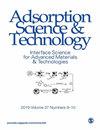基于碳的污水处理厂智能预测的机器学习算法
IF 3.2
4区 工程技术
Q2 CHEMISTRY, APPLIED
引用次数: 8
摘要
净化被污染的水并返回农业领域是对植物的废水处理。受污染的水会引起公众的疾病和健康紧急情况。此外,有毒污染物的释放带来的健康风险给所有生物带来了问题。目前,传感器用于废水处理,并通过物联网(IoT)传输数据。总氮(T-N)和总磷(T-P)元素、化学需氧量(COD)、生化需氧量(BOD)和总悬浮物(TSS)的存在对废水质量含量的预测与应预防的富营养化有关。这可能导致藻类水华,破坏人类所消耗的水生生物。废水中含有氮和磷元素,这些元素与富营养化有关,应加以预防。T-N和T-P活性炭的吸附是最有前途的废水处理方法之一。已经做了许多研究工作。问题是废水处理预测效率低下。为了克服这个问题,本文提出了B-KNN与所使用的ELM算法的融合。BKNN-ELM算法在水质状况分类中的准确度最高,最高准确度K=9和K=10,准确率为93.56%,最低准确度K=1 属于 65.34%。实验评价表明,该模型预测的总悬浮固体为91个,准确率为93%。预测的相对误差率为12.03,低于现有模型。本文章由计算机程序翻译,如有差异,请以英文原文为准。
An Intelligent Carbon-Based Prediction of Wastewater Treatment Plants Using Machine Learning Algorithms
Purification of polluted water and return back to the agriculture field is the wastewater treatment for plants. Contaminated water causes illness and health emergencies of public. Also, health risk due release of toxic contaminants brings problem to all living beings. At present, sensors are used in waste water treatment and transfer data via internet of things (IoT). Prediction of wastewater quality content which is presence of total nitrogen (T-N) and total phosphorous (T-P) elements, chemical oxygen demand (COD), biochemical demand (BOD), and total suspended solids (TSS) is associated with eutrophication that should be prevented. This may leads to algal bloom and spoils aquatic life which is consumed by human. The presence of nitrogen and phosphorous elements is in the content of wastewater, and these elements are associated with eutrophication which should be prevented. Adsorption of T-N and T-P activated carbon was predictable as one of the most promising methods for wastewater treatment. Many research works have been done. The issues are inefficiency in the prediction of wastewater treatment. To overcome this issue, this paper proposed fusion of B-KNN with the ELM algorithm that is used. The accuracy of the BKNN-ELM algorithm in classification of water quality status produced the highest accuracy of the highest accuracy which is
K
=
9
and
k
=
10
with rate of accuracy which is 93.56%, and the lowest accuracy is
K
=
1
of
65.34
%
. Experiment evaluation shows that a total suspended solid predicted by proposed model is 91 with accuracy of 93%. The relative error rate of prediction is 12.03 which is lesser than existing models.
求助全文
通过发布文献求助,成功后即可免费获取论文全文。
去求助
来源期刊

Adsorption Science & Technology
工程技术-工程:化工
CiteScore
5.00
自引率
10.30%
发文量
181
审稿时长
4.5 months
期刊介绍:
Adsorption Science & Technology is a peer-reviewed, open access journal devoted to studies of adsorption and desorption phenomena, which publishes original research papers and critical review articles, with occasional special issues relating to particular topics and symposia.
 求助内容:
求助内容: 应助结果提醒方式:
应助结果提醒方式:


